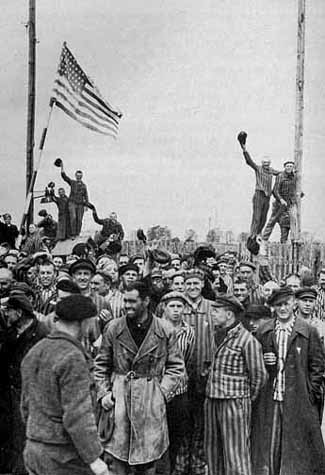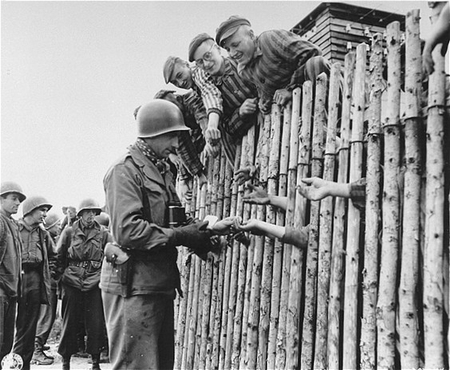Liberation of Allach, a Dachau sub-camp Allach was a sub-camp of Dachau near Munich, located approximately 10 miles from the main camp at Dachau. According to Marcus J. Smith, who wrote "Dachau: The Harrowing of Hell," the Allach camp was divided into two enclosures, one for 3,000 Jewish inmates and the other for 6,000 non-Jewish prisoners. Smith was a doctor in the US military, assigned to take over the care of the prisoners after the liberation. He wrote that the typhus epidemic had not reached Allach until April 22, 1945, about a week before the camp was liberated. One of the prisoners at the Allach sub-camp of Dachau was Leo Goldner, who was then 34 years old. According to Mr. Goldner, the photograph above was taken a few minutes after soldiers of the 42nd Rainbow Division entered the camp at around 9 o'clock on the morning of April 30, 1945, one day after the main camp at Dachau was liberated. Since that day, Mr. Goldner says that he has been celebrating his "second birthday" on April 30. The first US soldier arrived at the gate and announced to the prisoners "You are free!!!" Mr. Goldner asked the soldier for his name and home address: the man who was Mr. Goldner's "personal liberator" was George Thomann from Akron, Ohio.  Leo Goldner's account of the liberation of Allach is as follows: "One day before liberation , we, the prisoners learned somehow that our liberation was imminent. During the night from (April) 29 to 30, the camp was attacked by US artillery and had some victims, but the target was a German Air Defense unit, situated in the vicinity of the camp. During the twilight of the morning, both the SS from the camp and the German military from the Air Defense disappeared." Another prisoner who survived Allach was Max Mannheimer, who became well known as a tour guide at the Dachau main camp and a lecturer for high school classes on the Holocaust in Germany. Mannheimer was transferred to a Dachau sub-camp in Mühldorf near the end of the war; he was liberated by American troops on April 30, 1945.  The 66th Field Hospital, attached to the 42nd Division of the US Seventh Army, was brought to Allach to take care of the sick prisoners. By May 10th, they had moved on to help with the typhus epidemic in the main camp. George Tievsky was a Jewish doctor with the 66th Field Hospital. In 2001, he spoke to a group, telling them "I was a personal witness of the liberaton of Dachau. It was so unspeakable and I could not speak of it for 40 years." Tievsky died at the age of 89 on April 16, 2007. The following quote is from his obituary in the Washington Post: In a discussion for the Holocaust documentary "To Bear Witness," Dr. Tievsky recalled the horrors of what he saw. "I walked the streets of the pleasant, pretty little village of Dachau, and I could smell the smell of the death camp. I said to myself, how could this be?" Boris Kobe (1905 - 1981), a Slovenian architect and painter, was a political prisoner at Allach; he painted a set of Taro cards while he was a prisoner at Allach in 1945. Liberation of Ampfing sub campLiberation of Kaufering IV sub-campBack to Dachau Liberation DayReturn to Table of ContentsHome |